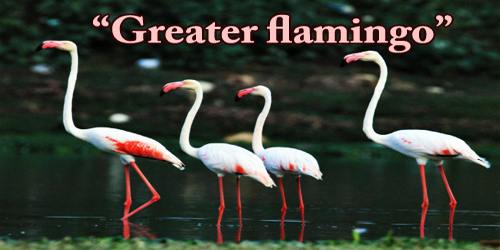The greater flamingos (Phoenicopterus roseus) are the largest member of the flamingo family and they are the most widespread. They stand at 1.5 m (5 ft) tall, they have a wingspan between 1.4 and 1.7 m (4.5 – 5.5 ft) and they weigh up to 4 Kgs (8.75 lbs). It is found in Africa, on the Indian subcontinent, in the Middle East, and in southern Europe. The greater flamingo was described by Peter Simon Pallas in 1811. It was previously thought to be the same species as the American flamingo (Phoenicopterus ruber), but because of coloring differences of its head, neck, body, and bill, the two flamingos are now most commonly considered separate species. The greater flamingo has no subspecies.
Greater flamingos are likely to be the only tall, pink bird in any given locale. They also have long, lean, curved necks and black-tipped bills with a distinctive downward bend. Their bent bills allow them to feed on small organism’s plankton, tiny fish, fly larvae, and the like. The greater flamingo is the largest living species of flamingo, averaging 110–150 cm (43–59 in) tall and weighing 2–4 kg (4.4–8.8 lb). The largest male flamingos have been recorded at up to 187 cm (74 in) tall and 4.5 kg (9.9 lb). In muddy flats or shallow water, they use their long legs and webbed feet to stir up the bottom. They then bury their bills, or even their entire heads, and suck up both mud and water to access the tasty morsels within. A flamingo’s beak has a filter-like structure to remove food from the water before the liquid is expelled. Greater Flamingos have a loud, deep honking call that is similar to that of a goose. They call loudly during courtship but they have a quieter call while they are feeding. They produce one chalky white egg that is laid on a mud mound in shallow water. The nest of each pair is situated approximately 1.5 m (4.9 ft) from neighboring nests so the chick remains safe from other breeding pairs. Both parents incubate the egg which takes 27 – 31 days to hatch. They will defend their nest during the breeding season, otherwise, they are non-territorial. After the chick first hatches they are fed a substance called “crop milk” which comes from the parents’ upper digestive tract. Either parent can feed the chick this way and other flamingos can act as foster feeders. When the chicks are old enough to walk they gather together in creches that are watched over by a few adult birds. By the time young flamingos reach 2 – 3 years of age, they will have gained their full adult plumage.
Greater Flamingos are found in both freshwater and saltwater habitats of Central and South America, the Caribbean, southwest Europe, Asia, and Africa. They live on lakes, estuaries, and lagoons and Greater Flamingos that live outside the tropics often migrate to warmer climates for the winter months. They live in colonies but this range vastly in size. They can consist of thousands of birds, but in some areas such as the Galapagos Islands, they may only consist of a few dozen birds. The greater flamingo resides in mudflats and shallow coastal lagoons with saltwater. Using its feet, the bird stirs up the mud and then sucks water through its bill and filters out small shrimp, seeds, blue-green algae, microscopic organisms, and mollusks. The greater flamingo feeds with its head down, and its upper jaw is movable and not rigidly fixed to its skull. Like all flamingos, this species lays a single chalky-white egg on a mud mound. The typical lifespan in captivity, according to Basel Zoo, is over 60 years. In the wild, the average lifespan is 30 – 40 years. The male is bigger than the female, and juveniles have a gray-brown coloration, with some pink on their underparts, tail, and wings, with the legs and beak being mainly brown.
















